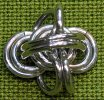I was playing with Orc weave, starting with the 1-2-1-2-1 pattern of the Orc weave start. My goal was to emphasize the radiating concentric ring effect of Orc. While streamlining Orc I included a maneuver similar to that in other weaves such as Aura and Celtic Mosaic, although I flip both rings to one side before pulling them back through a spread-apart pair of linking rings (as opposed to flipping one ring on each side of the chain before pulling them out through the pair of spread-apart connecting rings). I wound up with the unit I call Solar Flare. Just curious...Is this a weave or just a design?
You are using an out of date browser. It may not display this or other websites correctly.
You should upgrade or use an alternative browser.
You should upgrade or use an alternative browser.
Solar Flare - how new is it?
- Thread starter SueS
- Start date
"just" a design?
While there's clout historically for coming up with "weaves", designs are applied, and as such more copyrightable.
Regardless, intricate designs can be beautiful and bragworthy.
I really like the tighter version - but it feels like the ring sizes could be streamlined further? i.e, the Big bolty rings look like they could be the same size as the small bolty rings?
I'll wait until scott does a render to analyse this fully. - in the meantime; is it possible to get a picture of a single subunit, with only the two connectors?
While there's clout historically for coming up with "weaves", designs are applied, and as such more copyrightable.
Regardless, intricate designs can be beautiful and bragworthy.
I really like the tighter version - but it feels like the ring sizes could be streamlined further? i.e, the Big bolty rings look like they could be the same size as the small bolty rings?
I'll wait until scott does a render to analyse this fully. - in the meantime; is it possible to get a picture of a single subunit, with only the two connectors?
Thanks for your input, Karpeth! Single subunits are shown in the tutorial I posted. -SueS"just" a design?
While there's clout historically for coming up with "weaves", designs are applied, and as such more copyrightable.
Regardless, intricate designs can be beautiful and bragworthy.
I really like the tighter version - but it feels like the ring sizes could be streamlined further? i.e, the Big bolty rings look like they could be the same size as the small bolty rings?
I'll wait until scott does a render to analyse this fully. - in the meantime; is it possible to get a picture of a single subunit, with only the two connectors?
I’ll see if I get around to making a sample, before scott renders.Thanks for your input, Karpeth! Single subunits are shown in the tutorial I posted. -SueS
As a general rule of thumb, most people hold today that unneccesarily stacked or nested rings, do not constitute a different weave than with lone rings.
As such the core weave should (with some exceptions) be represented with as few rings as possible.
Do you happen to have the original full size pictures that you used in your pdf? At the size they are in the pdf, about all I can make out is that I'm looking at some stacked and possibly nested rings. If I enlarge them to try and see structure, they're not clear enough.I was playing with Orc weave, starting with the 1-2-1-2-1 pattern of the Orc weave start. My goal was to emphasize the radiating concentric ring effect of Orc. While streamlining Orc I included a maneuver similar to that in other weaves such as Aura and Celtic Mosaic, although I flip both rings to one side before pulling them back through a spread-apart pair of linking rings (as opposed to flipping one ring on each side of the chain before pulling them out through the pair of spread-apart connecting rings). I wound up with the unit I call Solar Flare. Just curious...Is this a weave or just a design?
Design is, in most cases, a word used to somehow try and take ownership of a specific concept applied to a specific weave that, in most cases, can be equally applied to any weave.
I don't know that there is such a thing as necessarily stacked or nested rings; true stacks or nests do nothing to change the structure of a weave. If anything, they fill space and/or make other rings less "floppy".As a general rule of thumb, most people hold today that unneccesarily stacked or nested rings, do not constitute a different weave than with lone rings.
Half Persian 2-1 requires nesting. Certain weaves, such as spiral weaves dramatically stabilize by stacking.I don't know that there is such a thing as necessarily stacked or nested rings; true stacks or nests do nothing to change the structure of a weave. If anything, they fill space and/or make other rings less "floppy".
In 99.9% of the cases, I agree with you tho.
Half Persian 2-1 is a stabilized 2 in 1 chain. It is not really Half Persian (as there are no inverted locks), it just mimics the appearance of a Half Persian chain. That's why I changed the listing to 2 in 1 Chain - Persian Form (Nested). 
Stacking and Nesting doesn't change the structure. Kings Maille is still E4 in 1, just stacked. Spiral 8 in 2 is still Spiral 4 in 1, just stacked. Helm (Paddle Wheel) is still Helm, just nested. Vertebrae is still E4 in 1, just nested.
Either way, we're not talking about stability, we're talking about structure
Stacking and Nesting doesn't change the structure. Kings Maille is still E4 in 1, just stacked. Spiral 8 in 2 is still Spiral 4 in 1, just stacked. Helm (Paddle Wheel) is still Helm, just nested. Vertebrae is still E4 in 1, just nested.
Either way, we're not talking about stability, we're talking about structure
Here are some higher resolution pictures. Regarding "design", I shouldn't have used the word "just". That was unfortunate. I delight in the imaginative things people create from established weaves in chain mail and do not mean to diminish those accomplishments. I agree with Karpeth's idea of "application" of a structure in a novel way for "design" as opposed to a novel relationship of rings in the weaving for "weave".
Attachments
Half Persian 2-1 is a stabilized 2 in 1 chain. It is not really Half Persian (as there are no inverted locks), it just mimics the appearance of a Half Persian chain. That's why I changed the listing to 2 in 1 Chain - Persian Form (Nested).
Stacking and Nesting doesn't change the structure. Kings Maille is still E4 in 1, just stacked. Spiral 8 in 2 is still Spiral 4 in 1, just stacked. Helm (Paddle Wheel) is still Helm, just nested. Vertebrae is still E4 in 1, just nested.
Either way, we're not talking about stability, we're talking about structure
Inverted locks?
For me, HP has always been defined by the eye interactions. Extrapolating the tables in this article, HP2-1 is a valid concept. https://www.mailleartisans.org/articles/articledisplay.php?key=755
HP2-1 is the only weave that really needs nesting - it changes the structure from non-stable protoweave to stable weave.
But as I said - We agree, mostly.
The point I was trying to make was that several rings in "Solar Flare" seems unneccessarily stacked or nested.
Here are some higher resolution pictures. Regarding "design", I shouldn't have used the word "just". That was unfortunate. I delight in the imaginative things people create from established weaves in chain mail and do not mean to diminish those accomplishments. I agree with Karpeth's idea of "application" of a structure in a novel way for "design" as opposed to a novel relationship of rings in the weaving for "weave".
So, this is a "reinforced" gridlock?
You've reinforced a nested Gridlock Sheet segment/terminated gridlock cell.Here are some higher resolution pictures. Regarding "design", I shouldn't have used the word "just". That was unfortunate. I delight in the imaginative things people create from established weaves in chain mail and do not mean to diminish those accomplishments. I agree with Karpeth's idea of "application" of a structure in a novel way for "design" as opposed to a novel relationship of rings in the weaving for "weave".
I am on the fence on calling this a unique weave.
It's close to barrel and RSD in "weavyness".
Pros:
This certain way of reinforcement, I don't think I've seen.
Cons:
This is not fully take to its logical consequenses.
It's close to barrel and RSD in "weavyness".
Pros:
This certain way of reinforcement, I don't think I've seen.
Cons:
This is not fully take to its logical consequenses.
I've told you multiple times that I don't look at things the same wayInverted locks?
For me, HP has always been defined by the eye interactions. Extrapolating the tables in this article, HP2-1 is a valid concept. https://www.mailleartisans.org/articles/articledisplay.php?key=755
Based on CCT, HP2-1 can never exist as more than a segment of HP3-1 (made up of 2 root cells). As soon as you add a third cell, it becomes HP 3 in 1.
There are currently, 4 recognized connection types in CCT
- Direct
- Inverted
- Inverted lock
- Orbital
S SueS I didn't forget about you, have to do some renders for your reply
Thank you very much for the pictures, makes things much easierHere are some higher resolution pictures. Regarding "design", I shouldn't have used the word "just". That was unfortunate. I delight in the imaginative things people create from established weaves in chain mail and do not mean to diminish those accomplishments. I agree with Karpeth's idea of "application" of a structure in a novel way for "design" as opposed to a novel relationship of rings in the weaving for "weave".
Now a few things about what you posted here:
- The novel thing about it is that your variation is essentially a hybrid of both stacking and nesting. To be honest, I'm not sure how I feel about it (the hybrid itself). It will warrant further examination.
- This is a "perfect" render of the subunit you're describing (I don't have to worry about pesky things like physics
) Stainless rings are the base, cyan rings are the variation rings.
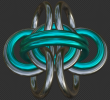
- if we take away the variations from what you call a "subunit", we're left with what I call a "terminated weave cell" of Gridlock.
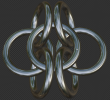
- Listen up
 Karpeth
because I'm only going to explain this to you once, after this, you'll have to wait till I publish something. (Everyone else can ask questions though) J/K, you can ask questions too
Karpeth
because I'm only going to explain this to you once, after this, you'll have to wait till I publish something. (Everyone else can ask questions though) J/K, you can ask questions too - What is a Termination? A termination is any ring/cell that stops direct translation along the axis you would like to repeat the weave cell. A terminating ring/cell would usually be part of the next cell in a weave form.
- Why is it considered terminated? It is considered "terminated" because a Direct Translation can not be applied. (the red rings would collide).
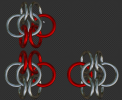
- What is a Direct Translation? A Translation is a type of Geometric Transformation. CCT (Cellular Chainmaille Theory) is based on making Extensions, Expansions and Elevations through this and other Transformations. A Direct Translation is taking a carbon copy of a set of rings and their connections and sliding it along an axis or axes (working definition).
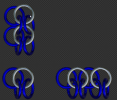
- CCT Basics course over, back to Solar Flare
- Listen up
- To explain Solar Flare, I'll show you how CCT sees it:
- Take a terminated weave cell Gridlock and rotate it (another Geometric Transformation, this specific rotation I call a "spin")
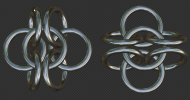
- Next add the stack/nest hybrid rings and then the reinforcing rings
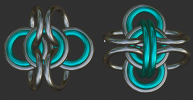
- I know
 Karpeth
is going to hate what I say next
Karpeth
is going to hate what I say next Fold two terminal rings outward and then make a reflective radial 2 unit out of it (physics are acting a little wonky on this one)
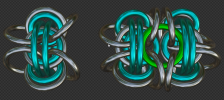
- Then we tether (because it's terminated) that and we have our Directly Translatable weave cell

- Take a terminated weave cell Gridlock and rotate it (another Geometric Transformation, this specific rotation I call a "spin")

While it has things in common with Orc Weave (as I would expect it to being based off of Gridlock) it is definitely not the same.
And at that, I have no idea where I was going with this, but I'm going to eat dinner now
There's one thing I see, that I missed in my first viewing - it's extra gridlocked. change the purple for the green, like in the pdfs grotto, and you do have an interesting weave that I can't say I've seen before, and with the right ringsizes, also sheets.Thank you very much for the pictures, makes things much easierFirst I want make sure that you know that nothing I said (or say) with regards to weaves should be taken personally. The only thing that I'm interested in is the structure that makes up a finished chainmaille form. As far as I'm concerned, the smallest modification, has the potential to structurally change a weave into something "other". Everything in chainmaille can be traced back to a root cell (two connected rings) if you go back far enough
Now a few things about what you posted here:
- The novel thing about it is that your variation is essentially a hybrid of both stacking and nesting. To be honest, I'm not sure how I feel about it (the hybrid itself). It will warrant further examination.
- This is a "perfect" render of the subunit you're describing (I don't have to worry about pesky things like physics
) Stainless rings are the base, cyan rings are the variation rings.
View attachment 7576- if we take away the variations from what you call a "subunit", we're left with what I call a "terminated weave cell" of Gridlock.
View attachment 7577
- Listen up
Karpeth because I'm only going to explain this to you once, after this, you'll have to wait till I publish something. (Everyone else can ask questions though) J/K, you can ask questions too
- What is a Termination? A termination is any ring/cell that stops direct translation along the axis you would like to repeat the weave cell. A terminating ring/cell would usually be part of the next cell in a weave form.
- Why is it considered terminated? It is considered "terminated" because a Direct Translation can not be applied. (the red rings would collide).
View attachment 7578- What is a Direct Translation? A Translation is a type of Geometric Transformation. CCT (Cellular Chainmaille Theory) is based on making Extensions, Expansions and Elevations through this and other Transformations. A Direct Translation is taking a carbon copy of a set of rings and their connections and sliding it along an axis or axes (working definition).
View attachment 7579- CCT Basics course over, back to Solar Flare
Now the real question is what do we have if we remove the modifications?
- To explain Solar Flare, I'll show you how CCT sees it:
- Take a terminated weave cell Gridlock and rotate it (another Geometric Transformation, this specific rotation I call a "spin")
View attachment 7580- Next add the stack/nest hybrid rings and then the reinforcing rings
View attachment 7581- I know
Karpeth is going to hate what I say next
Fold two terminal rings outward and then make a reflective radial 2 unit out of it (physics are acting a little wonky on this one)
View attachment 7583- Then we tether (because it's terminated) that and we have our Directly Translatable weave cell
View attachment 7584
View attachment 7585
While it has things in common with Orc Weave (as I would expect it to being based off of Gridlock) it is definitely not the same.
And at that, I have no idea where I was going with this, but I'm going to eat dinner now
Thank you so much for a fantastic discussion and insight! I hope your dinner was still warm. SueSThank you very much for the pictures, makes things much easierFirst I want make sure that you know that nothing I said (or say) with regards to weaves should be taken personally. The only thing that I'm interested in is the structure that makes up a finished chainmaille form. As far as I'm concerned, the smallest modification, has the potential to structurally change a weave into something "other". Everything in chainmaille can be traced back to a root cell (two connected rings) if you go back far enough
Now a few things about what you posted here:
- The novel thing about it is that your variation is essentially a hybrid of both stacking and nesting. To be honest, I'm not sure how I feel about it (the hybrid itself). It will warrant further examination.
- This is a "perfect" render of the subunit you're describing (I don't have to worry about pesky things like physics
) Stainless rings are the base, cyan rings are the variation rings.
View attachment 7576
- if we take away the variations from what you call a "subunit", we're left with what I call a "terminated weave cell" of Gridlock.
View attachment 7577
- Listen up
Karpeth because I'm only going to explain this to you once, after this, you'll have to wait till I publish something. (Everyone else can ask questions though) J/K, you can ask questions too

- What is a Termination? A termination is any ring/cell that stops direct translation along the axis you would like to repeat the weave cell. A terminating ring/cell would usually be part of the next cell in a weave form.
- Why is it considered terminated? It is considered "terminated" because a Direct Translation can not be applied. (the red rings would collide).
View attachment 7578
- What is a Direct Translation? A Translation is a type of Geometric Transformation. CCT (Cellular Chainmaille Theory) is based on making Extensions, Expansions and Elevations through this and other Transformations. A Direct Translation is taking a carbon copy of a set of rings and their connections and sliding it along an axis or axes (working definition).
View attachment 7579
- CCT Basics course over, back to Solar Flare
Now the real question is what do we have if we remove the modifications?
- To explain Solar Flare, I'll show you how CCT sees it:
- Take a terminated weave cell Gridlock and rotate it (another Geometric Transformation, this specific rotation I call a "spin")
View attachment 7580- Next add the stack/nest hybrid rings and then the reinforcing rings
View attachment 7581
- I know
Karpeth is going to hate what I say next
Fold two terminal rings outward and then make a reflective radial 2 unit out of it (physics are acting a little wonky on this one)
View attachment 7583
- Then we tether (because it's terminated) that and we have our Directly Translatable weave cell
View attachment 7584
View attachment 7585
While it has things in common with Orc Weave (as I would expect it to being based off of Gridlock) it is definitely not the same.
And at that, I have no idea where I was going with this, but I'm going to eat dinner now



